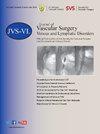Thigh muscle pump function during ambulation
IF 2.8
2区 医学
Q2 PERIPHERAL VASCULAR DISEASE
Journal of vascular surgery. Venous and lymphatic disorders
Pub Date : 2025-04-08
DOI:10.1016/j.jvsv.2025.102248
引用次数: 0
Abstract
Objective
It is generally accepted that blood flow in the superficial venous system of the lower extremity is anterograde whether the body is at rest (lying, sitting, or standing) or in motion (walking). However, it has been shown that during locomotion, anterograde blood flow in the superficial veins from the calf to the thigh was not observed. Instead, the blood flowed towards the intramuscular veins of the lower leg. The purpose of this study was to determine the pressure gradient directing the blood flow in the thigh venous network during ambulation.
Methods
Sixteen healthy volunteers (legs) were enrolled in the study. Venous pressure was measured in the great saphenous vein (GSV) at the upper and distal thigh and in the intermuscular vein of the posterior thigh during treadmill walking at 30, 45 and 60 stride cycles min−1. The blood flow rate in the common femoral artery was measured by duplex ultrasound at rest and immediately following each exercise test.
Results
Fourteen lower extremities were included in the analysis; two were excluded due to technical failure. A pressure gradient (PG) directed from the superficial to the intermuscular vein was observed for the majority the stride cycle time. The magnitude of the PG from the superficial to the intermuscular vein was found to be considerably higher than the PG observed between knee and groin GSV levels. The GSV pressure averaged over the cycle time was found to be similar at the knee and groin levels, irrespective of walking frequency.
Conclusions
During natural ambulation, the resulting PG was directed from superficial to intermuscular veins for the majority of the stride cycle time. The thigh muscle pump functions as a flow diverter pump, redirecting blood flow from the superficial to the intramuscular venous networks via perforating veins.
Clinical Relevance
This report addresses the mechanical aspects of the thigh muscle pump during human locomotion, specifically treadmill walking. The study establishes a correlation between the stride cycle and venous pressure changes within the thigh intermuscular and superficial venous network. The study demonstrated that the direction of blood flow from superficial veins is not anterograde; rather, the primary route for blood outflow from the superficial venous network at the thigh level is towards intramuscular veins through perforating veins. The aforementioned data, when considered alongside recently published data regarding calf muscle pump function, strongly suggest that the physiologic direction of blood flow in perforating veins is only from superficial to deep veins. Conversely, the occurrence of reverse flow should be regarded as pathological, even if observed in a healthy subject with so-called bi-directional perforating veins. The role of bi-directional perforating veins has been a topic of long-standing debate in the literature, with opinions divided as to whether they are a physiological or pathological phenomenon. This new data is valuable for future research on the pathophysiology of chronic venous insufficiency.



行走时大腿肌肉泵功能。
目的:无论身体处于静止(躺、坐、站)或运动(行走)状态,下肢浅静脉系统的血流都是顺行的,这是目前公认的观点。然而,研究表明,在运动过程中,没有观察到从小腿到大腿的浅静脉的顺行血流。相反,血液流向了小腿的肌内静脉。本研究的目的是确定压力梯度指导血液流动的大腿静脉网络在走动。方法:16名健康志愿者(腿)参加研究。在跑步机上行走30,45和60步循环min-1时,测量大腿上、远端大隐静脉(GSV)和大腿后肌间静脉的静脉压。在静息时和每次运动试验后立即用双工超声测量股总动脉的血流量。结果:14条下肢被纳入分析;其中2人因技术故障被排除。在步幅周期的大部分时间内,观察到从浅表静脉到肌间静脉的压力梯度(PG)。从浅表到肌间静脉的PG值明显高于膝关节和腹股沟GSV水平之间的PG值。无论行走频率如何,在整个周期内,膝关节和腹股沟水平的平均GSV压力是相似的。结论:在自然行走过程中,所产生的PG在大部分步幅周期时间内由浅表静脉指向肌间静脉。大腿肌泵的功能是作为血流分流泵,通过穿静脉将血液从浅表流向肌肉内静脉网络。临床相关性:本报告探讨了人体运动时大腿肌肉泵的机械方面,特别是跑步机行走。该研究建立了跨步周期与大腿肌间和浅静脉网络内静脉压力变化之间的相关性。研究表明,浅静脉血流方向并非顺行;相反,血液从大腿水平的浅静脉网络流出的主要途径是通过穿静脉流向肌内静脉。上述数据,与最近发表的小腿肌肉泵功能数据一起考虑,强烈表明穿孔静脉的血液流动的生理方向只是从浅静脉到深静脉。相反,即使在具有所谓双向穿静脉的健康受试者中观察到反向血流,也应被视为病理。双向穿静脉的作用一直是文献中一个长期争论的话题,关于它们是生理现象还是病理现象,意见分歧。这一新数据对今后慢性静脉功能不全的病理生理学研究具有重要价值。
本文章由计算机程序翻译,如有差异,请以英文原文为准。
求助全文
约1分钟内获得全文
求助全文
来源期刊

Journal of vascular surgery. Venous and lymphatic disorders
SURGERYPERIPHERAL VASCULAR DISEASE&n-PERIPHERAL VASCULAR DISEASE
CiteScore
6.30
自引率
18.80%
发文量
328
审稿时长
71 days
期刊介绍:
Journal of Vascular Surgery: Venous and Lymphatic Disorders is one of a series of specialist journals launched by the Journal of Vascular Surgery. It aims to be the premier international Journal of medical, endovascular and surgical management of venous and lymphatic disorders. It publishes high quality clinical, research, case reports, techniques, and practice manuscripts related to all aspects of venous and lymphatic disorders, including malformations and wound care, with an emphasis on the practicing clinician. The journal seeks to provide novel and timely information to vascular surgeons, interventionalists, phlebologists, wound care specialists, and allied health professionals who treat patients presenting with vascular and lymphatic disorders. As the official publication of The Society for Vascular Surgery and the American Venous Forum, the Journal will publish, after peer review, selected papers presented at the annual meeting of these organizations and affiliated vascular societies, as well as original articles from members and non-members.
 求助内容:
求助内容: 应助结果提醒方式:
应助结果提醒方式:


